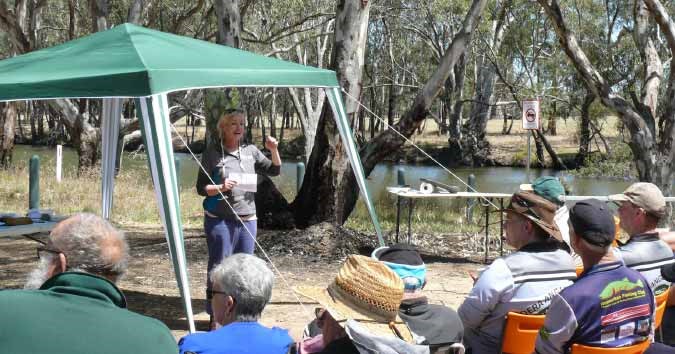Recreational fishers in northern Victoria joined forces with scientists to find out how water for the environment helps the migration, spawning and survival of native fish.
Every year thousands of Victorians head to local waterways to catch fish. For those who keep Murray cod and golden perch for the dinner table, they were asked to help the scientists at the Arthur Rylah Institute (ARI) discover how fish populations have benefitted from environmental flows. All they needed to do was hold on to a part of each fish that they would normally throw away – its ‘ear bones.’
These ear bones, found at the back of the fish head, are actually calcium carbonate structures called ‘otoliths’, and play a role in balance and hearing. They are made up of layers like miniature tree rings, and when examined under the microscope, they can reveal an amazing amount about the origin, age, growth and movement history of a fish, and even whether it is a stocked fish or a natural recruit.
“We’ve been partnering with fishing clubs, North Central CMA and Goulburn Broken CMA since early 2018 to collect this useful data,” ARI’s Pam Clunie explained.
“The angler scientists are really interested in the work that’s happening to support and monitor our native fish, and they understand the important contribution they’re making to our scientific knowledge.”
In November 2018, angler scientists and staff from the ARI, North Central CMA and the Victorian Fisheries Authority got together on the Campaspe River near Elmore to have a go at extracting fish otoliths (ear bones), hear about environmental flows and fish monitoring, and enjoy a barbeque.
Plenty of keen angler scientists came along - some with frozen fish heads and some with ear bones already extracted! Anglers practiced extracting the ear bones, under the guidance of ARI experts.
Fishing club members, along with individual recreational fishers from across northern Victoria, collected ear bones from fish caught in waterways including the mid-Murray, Goulburn, Broken, Loddon and Campaspe rivers, and Pyramid and Gunbower creeks.
“We’ve collected 84 golden perch ear bones and 25 Murray cod ear bones during the project, which is a great result. Once we’ve finished the analysis, every angler will receive a ‘fish profile’, telling them all about each of the fish they collected!” said Pam.
“There are so many benefits to citizen science projects such as this. Angler scientists help us gather a larger sample size to analyse, which will provide us with a better understanding of how fish respond to environmental flows. Scientists and anglers also build relationships and better understand each other’s perspectives and interests,” said Pam.
This work is part of the Victorian Environmental Flows Monitoring and Assessment Program (VEFMAP), which is monitoring how fish and vegetation along rivers respond to the delivery of water for the environment. This information in turn helps waterway managers to make informed decisions about where, when and how to deliver environmental flows.

Pam Clunie, ARI, talking at Angler Scientist field day at Aysons Reserve, by ARI
To find out more, contact Pam.Clunie@delwp.vic.gov.au or go to https://www.ari.vic.gov.au/research/people-and-nature/fishers-fishing-for-fish-ear-bones.